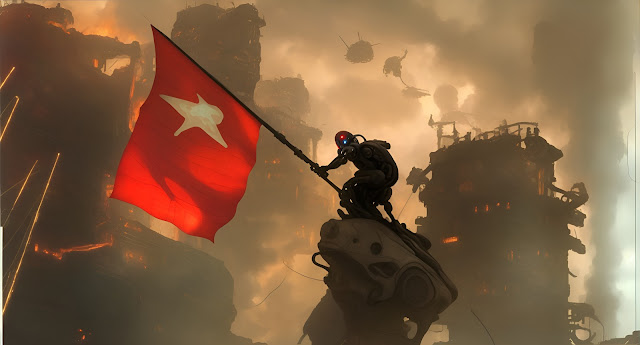Working on the red flag interpretation image
Using iconic photos and translating them into an AI context pendant was the initial idea of this project.
One of the images that came out throughout the hundreds of iteration is this one here:
This image is impressive, but it is not what I wanted. The surrounding buildings are higher than the object the flag carrier has climbed on. It is nice for a first try, but does not really match my consistent AI style.Here I will show some of the steps taken to receive the desired outcome. You will see, that the work was far more than just a click on the AI generator. In fact, achieving the desired visual output is often a hard and long-winded process.
Starting with some of the original photos made on 2nd of May 1945 on the Reichstag building by photographer Jewgeni Ananjewitsch Chaldei, one would think it is all easy.
Step 1: Use one of the black and white photos and have it run through an AI colorizer. In this case, https://deepai.org/machine-learning-model/colorizer was used, but the outcome was rather poor.
There were very few colors added. I manually recolored the uniforms of the soldiers with the original colors.
Working with this as a template, I imported it to Leonardo.Ai and used it as a seed for my individual prompt. The results were disappointing. Soon I came to the conclusion, that a large portion of that iconic "photo" has been hand-painted. Only a few parts in the foreground are from the initial photo. You can tell that by either enlarging the photo or carefully examining the background details. In addition, there is a wrong perspective of the buildings to the left. This wrong perspective gets even more dominant as I expanded the image using outpainting in Leonardos.AIs canvas tool.
No matter which setting, I never achieved my desired crystal-clear high-detail image. I spend around 2000 token experimenting, editing the colorized image in Gimp, manually adding colors, and trying to outpaint the image so it will have a 16:9 ratio at the end of teh procedure. I achieved impressive images if I let teh guidance to a very low value and reduced the init strength value, but all that came out had little to to with the original scene and setting.
I wanted to image to have the right perspective, which would be, looking down from the highest building in the area. I never achieved that. In addition, the soldiers in the image became blurry, combined with the building, or disappeared. The AI was not able to tell the soldiers from parts of the building as the colors and the details got crispier and more detailed.
After 2000 toke I was about to give up. Again: A large portion of the "photo" is painted and the perspectives are wrong. The AI will be influenced and return paintings instead of a hyperrealistic image and create buildings, that are much higher than the one the flag is placed on.
Then I started one last try and researched some Russian sites for additional photo material. My plan was to replace the parts that were painted by the real photographed images. I learned that Jewge Chaldei did take more than 20 photos.




.png)
.png)


Comments
Post a Comment